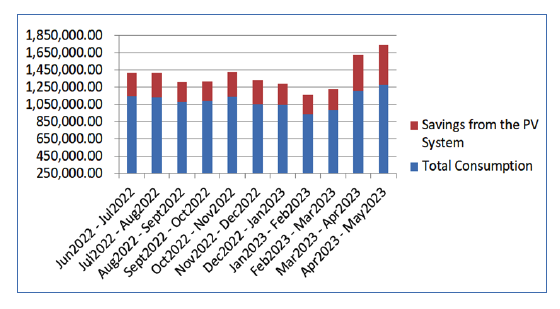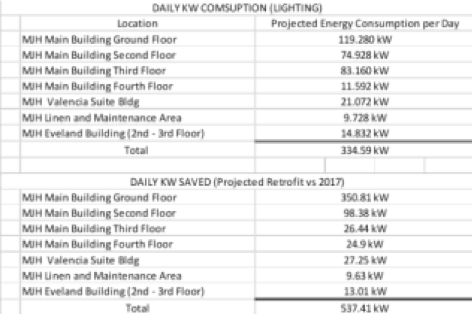Energy solutions for enhanced environmental and human health
Mary Johnston Hospital, Philippines
Case study summary
This case study highlights Mary Johnston Hospital’s energy solutions in response to the global call for environmental stewardship. It will also discuss the challenges, opportunities, and outcomes from each phase of the projects.
The summary is based on the initiative's implementation, which ran from January 2022 to May 2023.
Demographic information
- City: Manila
- State/province/region: National Capital Region
- Country: Philippines
- Type of institution: Private hospital and training institution
- Number of full-time staff: Organic employees: 283 as of December 2022
- Patient population served annually
- 18,243 patients served annually (total of inpatient and outpatient as of December 2022)
- Geographic area served: Tondo, Manila
- Top 1-3 health equity concerns experienced by the population:
- Access to public health
- Unstable waste management
- Costly electrical consumption
- Number of beds: 120-bed capacity
The issue
Southeast Asia’s hospital operations have contributed to more than 63 million metric tons (MMT) of carbon emissions every year. Additionally, the Philippines’ health care system has emitted more than 5.22 MMT of carbon dioxide annually, ranking it as 36th among 68 countries.
Climate change has aggravated health inequity in the Philippines, which ranked 120th out of 195 countries due to poor health accessibility and health care quality.
From 2019 to 2021, Mary Johnston Hospital (MJH) has spent P 29.6M or USD 539,000 for 2.4M kWh of electricity, an expense that could be redirected to subsidize diagnosis and treatment of lower-income TB and HIV-AIDS patients.
Hospital goal
MJH aims to save 35 to 44% of its electricity cost, generating savings ranging from P350,000 to P440,000 ($6,364 to USD 8,000) monthly. In addition, the hospital aims to reduce the use of harmful chemicals. By shifting to LED lighting, it focuses on removing an estimated 3 to 5 mg of mercury in single glass tubing.
Sustainability strategy implemented
As a result of various assessments, MJH prioritized and implemented two sustainable strategies:
- Alternative energy options: Renewable energy in the form of a solar PV system – installation of 1,024 panels with 389 kWh capacity.
- Shift to efficient light sources and elimination of toxins: Replacement of compact fluorescent lamps (CFL) with light-emitting diodes – substituted an estimated 1,426 CFLs and increased purchasing of sustainable and eco-friendly products.
Implementation process
MJH structured its health system for sustainability based on the World Health Organization framework of capacity, information, financing, and sustainability.
Capacity: MJH communicated the message to all key stakeholders. Efficient and cost-effective supplies, materials, and equipment were preferably procured.
Information: MJH ensured that awareness sessions increased participation and involvement among stakeholders. Online monitoring systems gathered real-time data for efficient reporting and decision-making.
Financing: MJH pursued partnerships with non-governmental organizations, local churches, and other institutions.
Sustainability: MJH guaranteed that all plans and actions were supported by an institutional policy, workflow process, and project plan.
During conceptualization, goals, objectives, and strategies were identified. Next came gaining the buy-in and support of the board of trustees, management, and staff. Institutional policies were developed to ensure governance. Lastly, outcomes were regularly monitored and evaluated to emphasize responsibility and accountability.
Tracking progress
MJH tracked each initiative’s progress through a comprehensive review of compliance and implementation of the timeline and work plan. Progress was categorized into observational and numerical.
Observational advancement considered policy development, partnership recognition, and project progression. MJH formulated its green and safe hospital policy and strengthened its networking with eco-friendly suppliers and partner institutions. It pursued the use of renewable energy through the installation of a solar PV system.
Numerical milestones were recorded and documented for each phase of the project plan.

Solar panel Meralco bill and savings (June 2022 to May 2023)
The solar PV system has generated savings of P 3,155,613.10 (USD 57,375) from June 2022 to May 2023, or an average savings of P 286,873.92 (USD 5,215) monthly. The system has covered 33 to 35% of actual electricity consumption. Using the real-time monitoring application, it has saved 126,562 kg of carbon dioxide emissions, the equivalent of planting an estimated 3,777 trees.
Hospital retrofitting: Shifting to mercury-free, low-cost, and energy-efficient lighting, energy savings
Projected savings from the retrofitting was P 5,374.00 (USD 98) per day or P 1,961,510 (USD 35,664) per year. The energy saved yearly was equivalent to 2,299 tree seedlings grown for 10 years, 165 acres of U.S. forest grown in one year, and 0.938 acres of U.S. forest preserved in one year.

Challenges and lessons learned
MJH encountered challenges and delays at almost every stage of each project. Resistance, even from stakeholders, was noted and used as an opportunity to improve. Behavioral change goes beyond behavior to encompass mindset and attitude.
Community buy-in is essential, along with awareness of messaging platforms, technology trends, budget projection, and governance for every project.
Next steps
Generally, MJH was empowered to continue its commitment to excellent human and environmental health. Specifically, MJH intends to refine its cross-subsidy program for diagnosis and treatment of TB and HIV patients. Savings from green initiatives will be utilized to enhance TB/HIV care, fund tests for 95 directly-observed therapy, short-course (TB-DOTS) and care for 18 indigent HIV-AIDS patients, and uphold accessibility and affordability.